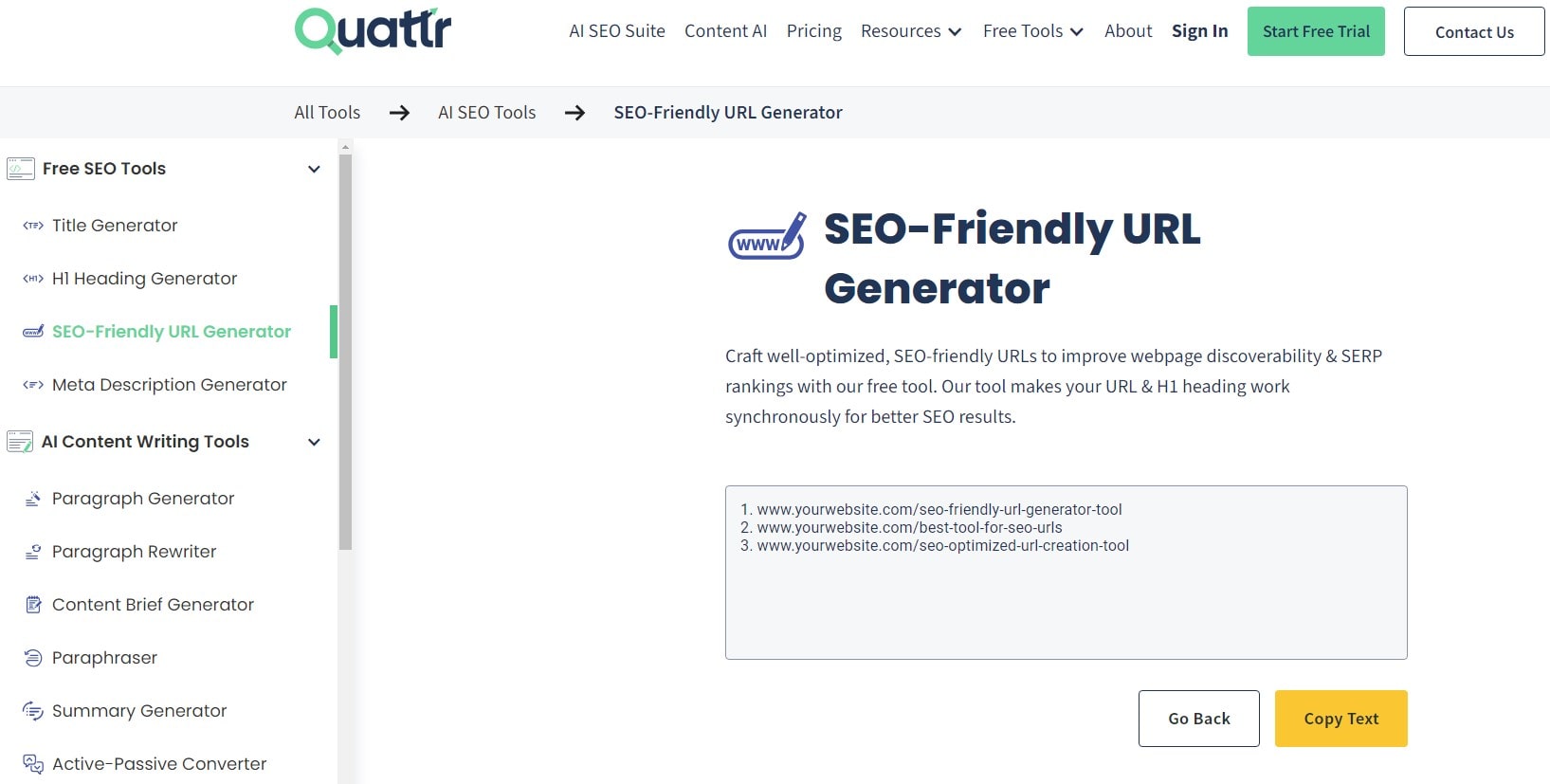Are you navigating the complexities of SEO-friendly URL structures and their impact on website performance? This intricate element of digital strategy holds more weight than is often perceived, directly influencing site rankings and user experience. Our article dives deep into the nuances of crafting URLs that resonate with search engine algorithms and enhance site navigability. We’ll explore strategic methods to optimize your web addresses, aligning them with SEO best practices and user expectations. By mastering this aspect, you unlock a new website efficiency and appeal level. Gain insights into optimizing your site’s architecture for peak performance. As you absorb these valuable strategies, consider Plerdy’s analytical tools – your ally in refining digital marketing efforts and understanding user behavior for continuous website enhancement.

Understanding SEO-Friendly URLs
Diving into the intricacies of SEO-friendly URLs, it’s essential to grasp their role as navigational signposts, guiding both search engines and users through your website’s content. These URLs, far from being mere web addresses, are pivotal for enhancing your site’s visibility and usability. Consider a well-structured URL – it’s akin to a clear, well-lit street sign, effortlessly directing traffic to the desired destination.
Here’s a breakdown of key components in crafting these URLs:
- Simplicity and Clarity: URLs should be straightforward, avoiding convoluted strings of characters. For instance, “www.example.com/shop/men/shoes” is far more effective than “www.example.com/item?category=12&product=45“.
- Keyword Integration: Embedding relevant keywords can significantly boost your SEO efforts. A URL like “www.example.com/gourmet-chocolate-truffles” instantly tells users and the Google search engine about the page’s content.
- Avoidance of Stop Words and Special Characters: Keeping URLs clean by excluding unnecessary fillers and symbols enhances readability and optimization.
- Consistent Structure Across the Site: Uniformity in URL structure across your website ensures a cohesive user experience and aids in search engine indexing.
In sectors like e-commerce, where product categorization is vital, a clear URL structure helps users navigate through product ranges efficiently. For instance, “www.ecomstore.com/women/dresses/evening-gowns” categorizes products in a logical, user-friendly manner. In the blogging sphere, a URL mirroring the post title, like “www.foodblog.com/gluten-free-baking-tips,” can significantly improve the page’s discoverability.
Mastering SEO-friendly URLs is an art – it requires balancing technical SEO with user experience, a combination that ensures both search engines and site visitors are seamlessly guided to the right content.
Examples and Best Practices for URL Optimization

In the world of URL optimization, a few keystrokes can make a sea change. Picture a URL as a digital fingerprint, unique and telling; it’s more than just an address, it’s a first impression, a welcome sign, a directional guide. Here’s how to ensure yours speaks volumes:
- Embrace Brevity and Precision: Keep URLs short, yet descriptive. For instance, “www.bakerycorner.com/fresh-blueberry-muffins” strikes a perfect balance.
- Incorporate Relevant Keywords: A URL should echo its page’s core content. “www.techbuzz.com/latest-smartphone-reviews” quickly informs users and search engines about the page’s focus.
- Use Hyphens to Separate Words: Hyphens enhance readability, making “www.gardeningenthusiast.com/watering-tips-for-roses” a clear and accessible URL.
- Steer Clear of Capital Letters and Special Characters: URLs like “www.example.com/Summer-Sale” or “www.example.com/about_us” can confuse users and search engines.
- Follow a Logical Structure: For e-commerce sites, “www.electronicshub.com/laptops/gaming” helps users navigate product categories efficiently.
- Ensure Consistency Across the Board: Uniform URL structures across your site, such as using a blog’s title in its URL, e.g., “www.healthylivingblog.com/eating-healthy-on-a-budget“, maintain a streamlined, professional look.
In niches like fashion retail, URL optimization turns a maze of products into an easy-to-navigate catalog. “www.fashionista.com/women/dresses/casual” categorizes effortlessly, guiding customers right to their desired product. For informational sites, URLs like “www.historybuff.com/ancient-civilizations/maya” break down topics into digestible paths, inviting deeper exploration. These practices turn URLs into powerful tools, not just pathways but storytellers, efficiency boosters, and engagement enhancers.
Step-by-Step Guide to Creating SEO-Friendly URLs
Crafting SEO-friendly URLs is like mapping a user-friendly journey through your website. It’s a process that demands precision and a keen eye for details. Here’s a straightforward guide to ensure your URLs not only rank well but also resonate with your audience:
- Start with a Solid Foundation: Your website’s domain should be straightforward and memorable. For a baking blog, “www.bakersdelight.com” sets the perfect stage.
- Prioritize Readability: URLs should be easy to understand at a glance. For a product page, “www.techhaven.com/smartphones/android/latest-model” is far more user-friendly than a string of incomprehensible numbers and letters.
- Incorporate Target Keywords: Identify the primary keywords for each page and weave them into your URLs. A fitness blog could use “www.fitfrenzy.com/workouts/cardio-for-beginners” to attract the right audience.
- Keep It Short and Sweet: Lengthy URLs lose impact. Aim for brevity while maintaining meaning, like “www.traveltrail.com/europe/france/paris-food-tour“.
- Use Hyphens for Separation: Separate words using hyphens to enhance readability – “www.gardenworld.com/plants/indoor-ferns” is preferable to underscores or spaces.
- Avoid Unnecessary Parameters: Steer clear of complex and irrelevant parameters in URLs. Opt for “www.bookworms.com/genres/fantasy” over “www.bookworms.com/category?genre=12“.
- Consistency is Key: Maintain a consistent URL structure across your website. If your blog titles translate into URLs, stick with this format for each post.
By following these steps, you tailor your website’s URLs not just for search engine algorithms but also for real people who appreciate clarity and ease of navigation. Whether you’re managing a bustling e-commerce platform or a niche hobby blog, these principles hold the key to making your URLs work harder for you.
Tools and Generators for SEO URLs

Navigating the seas of SEO can be smoother with the right tools and generators at your disposal, especially when it comes to crafting effective URLs. These digital assistants not only streamline the process but also infuse precision and SEO prowess into every web address you create.
- Automated URL Generators: Tools like Yoast SEO and Screaming Frog offer functionalities to automatically generate SEO-friendly URLs based on your content’s title or keywords. For instance, a bakery’s blog post titled “Gluten-Free Bread Recipes” would be neatly transformed into “www.bakeryblog.com/gluten-free-bread-recipes“.
- Customization Features: Advanced platforms provide options to customize URLs further. WordPress, for example, allows you to tweak your URL structure in the settings, giving you control over how your URLs are structured site-wide.
- Bulk URL Generators: For larger websites, bulk URL generators can save time. Tools like Bulk SEO Tools let you input multiple titles or keywords and generate URLs in bulk – a lifesaver for e-commerce sites with hundreds of product pages.
- URL Shorteners: Services like Bitly come in handy for social media sharing, providing shortened URLs that are more manageable and trackable.
- SEO Plugins: Plugins like All in One SEO Pack for WordPress automatically optimize your URLs, ensuring they are concise, keyword-rich, and devoid of unnecessary parameters.
These tools offer unique perspectives tailored to different needs – from the blogger seeking simplicity to the e-commerce giant managing thousands of product pages. Leveraging these tools ensures your URLs are not just strings of characters, but powerful elements enhancing your site’s SEO strategy.
Advanced URL Structure Considerations
When delving into advanced URL structure considerations, the approach transforms from basic SEO practices to a strategic art form. This advanced level of customization involves more than just inserting keywords; it’s about architecting a digital pathway that enhances user experience and aligns with search engine algorithms.
- Hierarchical Structuring: Implement a logical hierarchy in your URLs, reflecting the structure of your website. For instance, an online learning platform might use “www.edulearn.com/courses/digital-marketing/seo-basics” to indicate a clear path from general to specific.
- Canonical Tags for Duplicate Content: In instances where duplicate content is unavoidable, canonical tags become crucial. They signal to search engines which version of a URL should be considered the original, thus avoiding penalties for duplicate content.
- Mobile-Optimized URLs: As mobile browsing continues to rise, ensure your URLs are mobile-friendly. This involves avoiding overly long URLs and ensuring your site’s mobile version maintains consistent URL structure.
- Incorporating International SEO: For global websites, consider incorporating language or country codes, like “www.globetrotter.com/en-us/travel-tips” for U.S. English speakers or “www.globetrotter.com/fr-fr/conseils-voyage” for French speakers in France.
- Breadcrumb Navigation: Implementing breadcrumb trails in URLs, like “www.techgadget.com/home/electronics/smartphones”, not only improves user navigation but also helps search engines understand the website’s structure.
These advanced considerations require a balancing act – they must cater to the technical demands of search engines while ensuring a seamless and intuitive user experience. This intricate blend of technicality and user-centric design is what sets apart an optimally structured URL in today’s competitive digital space.
Optimizing URLs for Different Platforms

Optimizing URLs for different platforms is akin to tailoring a key to fit various locks, ensuring seamless access across diverse digital landscapes. Each platform, from WordPress to Shopify, demands its unique approach to URL optimization, marrying the platform’s technical requirements with SEO best practices.
- WordPress Optimization: Focus on permalinks. Choose a structure that includes post names, making URLs like “www.blogname.com/essential-seo-tips” both user and SEO-friendly.
- Shopify Specifics: Leverage Shopify’s built-in SEO features. Ensure your product pages have URLs like “www.shopname.com/products/handmade-wool-scarves“, which clearly convey the page’s content.
- Wix Websites: Wix automatically generates URLs based on page titles. Customize them for brevity and relevance, transforming a default URL into something like “www.wixsite.com/yoga-studio/classes“.
- Magento Mastery: Magento offers extensive customization. For product pages, structure URLs to include categories, like “www.magentostore.com/electronics/smartphones“.
- Squarespace Simplification: With Squarespace, keep it simple and descriptive. A gallery page could be “www.artiste.com/gallery/paintings“.
Each platform requires a nuanced approach, blending their inherent URL structuring methodologies with a keen SEO strategy. This tailored approach ensures that no matter the platform – be it an e-commerce giant like Shopify or a content-focused CMS like WordPress – your URLs stand out in the digital crowd, unlocking doors to higher traffic and better user engagement.
Technical Insights: Dynamic URLs and Coding for SEO
In the intricate web of SEO, dynamic URLs and coding stand as pillars of modern website architecture, playing a critical role in how efficiently search engines crawl and index a site. Understanding and optimizing these elements can significantly elevate a site’s SEO performance.
- Dynamic URL Optimization: Often generated from search queries or site interactions, dynamic URLs can be unwieldy. Simplifying these with URL rewriting techniques makes them more search-engine-friendly. For example, converting a URL from “www.store.com/products?item=123” to “www.store.com/products/red-sneakers” can enhance its SEO value.
- Efficient Coding Practices: Clean, streamlined code helps search engines parse your site more effectively. This includes using semantic HTML5 elements and ensuring your site’s CSS and JavaScript are minified and compressed.
- Implementation of Schema Markup: Adding schema markup to your site’s HTML code can significantly boost SEO. It helps search engines understand your content better, enhancing the richness of your site’s appearance in search results.
- Mobile Optimization: With Google’s mobile-first indexing, ensuring your site’s URLs and code are optimized for mobile devices is crucial. Responsive design and mobile-friendly URLs improve user experience and SEO.
- Utilizing CDN for Improved Performance: A Content Delivery Network (CDN) can speed up load times for your site, positively impacting SEO. It ensures that your site’s resources are loaded from servers close to the user, reducing latency.
These technical aspects, from URL structuring to backend coding, form a synergistic relationship with SEO. They are about meeting the technical requirements of search engines and enhancing the overall user experience, which is at the heart of SEO success.
SEO URL Structure for E-commerce and Blogs
In the bustling digital marketplace, an e-commerce site or blog’s success often hinges on the art of crafting SEO-friendly URLs. These URLs are the digital pathways that lead customers and readers directly to your content, playing a pivotal role in search engine visibility and user experience.
- E-commerce URL Best Practices:
- Use product names in URLs, like “www.fashionhub.com/women/dresses/summer-maxi-dress“.
- Keep categories and subcategories clear and concise, aiding in easier navigation.
- Avoid using IDs or numbers that add no value to the user or SEO.
- Blog URL Optimization:
- Include the blog post title or keywords, such as “www.techinsights.com/2023/08/smart-home-technology-trends“.
- Organize URLs by date or category for ease of access and clarity.
- Keep URLs short, removing filler words or unnecessary details.
For instance, an online bookstore might structure its URLs by genres and subgenres, such as “www.bookworld.com/genres/fiction/mystery-thrillers“, making it easy for book lovers to find exactly what they’re looking for. A travel blog, on the other hand, could use URLs like “www.globetrotter.com/destinations/europe/paris-budget-travel-tips“, which are not only SEO-friendly but also inform the reader about the content of the article. These structured URLs serve as clear, concise roadmaps in the vast digital landscape, guiding users to their desired destination with ease and precision.
Updating and Maintaining SEO-Friendly URL Structures
Maintaining and updating SEO-friendly URL structures is like tending a garden – it requires ongoing care and adaptation to keep it flourishing in the ever-evolving landscape of the internet. This process is crucial not only for sustaining your website’s health but also for ensuring its growth and visibility in search engine results.
- Regular Audits: Conduct periodic reviews of your site’s URLs to identify and rectify any issues, such as broken links or outdated keywords.
- Adapt to Content Changes: When updating site content, ensure your URLs reflect these changes. For example, if a digital marketing blog shifts its focus to social media trends, URLs should be updated from “www.marketingblog.com/seo-tips” to “www.marketingblog.com/social-media-trends“.
- Use Redirects Wisely: Implement 301 redirects for any changed URLs to preserve link equity and guide users to the new pages without hassle.
- Keep Track of URL Performance: Monitor your URLs’ performance using tools like Google Analytics. This data helps in making informed decisions about future changes.
- Consistency in Structure: Ensure that any new URLs follow the established structure of your site for uniformity and better user experience.
For instance, in an e-commerce setting specializing in outdoor gear, a product URL might evolve from “www.outdoorgear.com/products/hiking-boots” to “www.outdoorgear.com/hiking/footwear/boots” to reflect a more detailed categorization. Similarly, a food blog can update a URL from “www.foodieblog.com/recipes” to “www.foodieblog.com/vegan-recipes” to target a specific audience. Keeping URLs up-to-date and aligned with your site’s content and goals is not just about maintenance; it’s about staying relevant and visible in the digital world.
Bottom Line
As we weave the final threads of our exploration into SEO-friendly URL structures, it’s clear that mastering this aspect is not just a trend but an essential strategy. URLs, the backbone of any website, have evolved from mere digital addresses to powerful tools in the SEO arsenal. They are not just about facilitating easy navigation; they’re about speaking the language of search engines and users alike.
Incorporating practices like using relevant keywords, maintaining clarity with slashes, and avoiding unnecessary parameters transforms URLs into more than just pathways – they become storytellers. Whether it’s a local bakery using Opencart or a multilingual platform built on Laravel, the principles of SEO-friendly URLs remain steadfast.
Remember, it’s not just about where your URL leads but how it gets there. The journey – marked by clear, concise, and meaningful URLs – is as important as the destination. In a digital era where every character counts, let your URLs reflect your website’s purpose and potential. Follow these guidelines and watch your URLs boost your website’s visibility.
